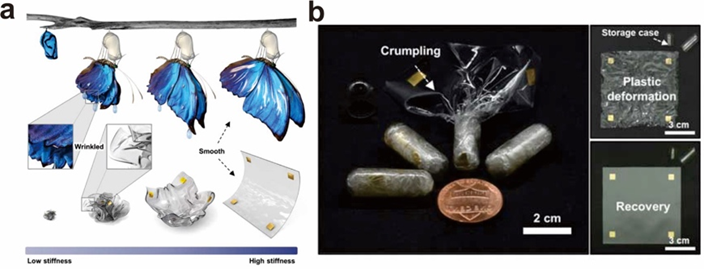In daily life, we often fold and crumple clothes to save space. However, can electronic devices be compressed in the same way? Conventional electronic devices consist of delicate and fragile components, making them susceptible to damage when folded, twisted, or compressed. Therefore, achieving foldable and compressible electronic devices is a challenging task. One approach is to design foldable flexible structures. For example, laser ablation techniques can be used to create folding lines on planar devices, enabling 3D folding similar to origami. However, as seen in existing products like foldable smartphones, this method can result in permanent creases that affect the practical use of the devices. Another approach is to use elastic materials as substrates, electrodes, and other functional materials in the devices. However, such devices often exhibit poor performance due to the unsatisfactory mechanical and electrical properties of elastic materials.
Recently, the research group of Professor Xuechang Zhou from Shenzhen University was invited to write an article titled "Electronics devices that can be crumpled and stored in capsules" in the "News & Views" column of the journal Nature Electronics (Nat Electron (2024). https://doi.org/10.1038/s41928-023-01108-6). Assistant Professor Yaokang Zhang is the first author of the article, and Professor Xuechang Zhou is the corresponding author. The article reviews the latest research porgress in the field of foldable electronic devices by a research team led by Je-Sung Koh, Daeshik Kang, and Seungyong Han from Ajou University in Korea (Nat Electron (2024). https://doi.org/10.1038/s41928-023-01089-6). The team drew inspiration from the emergence process of a butterfly from its pupa (Figure 1a): during this process, the butterfly's wings transition from an initially soft and folded state to a smooth state. Inspired by this process, the team combined shape-memory polymers, elastomers (polydimethylsiloxane), and conductive silver nanowires using a heterogeneously integrated structure. Under normal conditions, this system is plastic and can be crumpled and folded arbitrarily. When a voltage is applied to the silver nanowire network, the resulting Joule heating effect triggers a phase transition in the shape-memory polymer, transitioning it to an elastic state matching the softness of the polydimethylsiloxane, and thus restoring the entire system to a smooth and flat state. The mechanical and electrical performance are hardly affected even after being crumpled and restored for hundreds of times. Subsequently, the team used this composite material to develop foldable touch panels and flexible fluorescent displays, demonstrating the ability to store a 7 × 7 cm touch panel in a 1 ml capsule (Figure 1b).
Finally, this review article recognizes the potential application value of this novel material developed by the research team at Ajou University in future portable electronic devices, particularly in tablets and smartphones. The article also points out that future research should focus on developing consumer-grade foldable displays based on this material, such as OLED and QLED displays.

Figure 1. a) Illustration of the emergence process of a butterfly. b) Photographs of crumpled touch panels in capsules.
